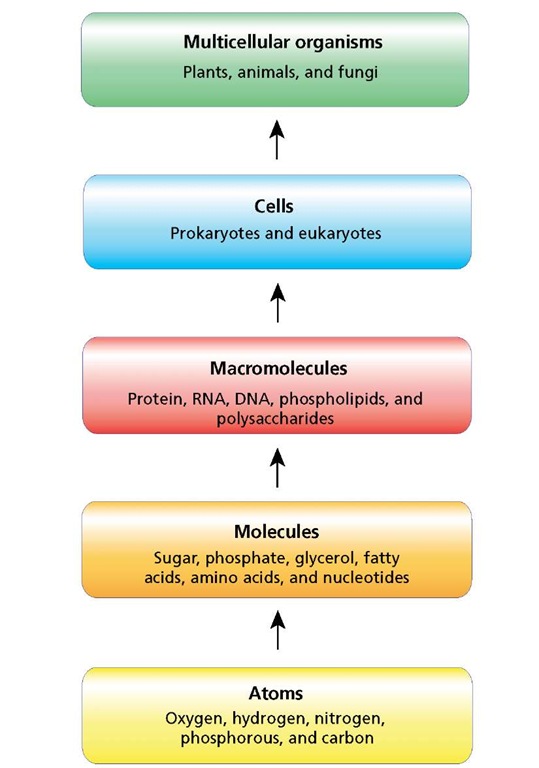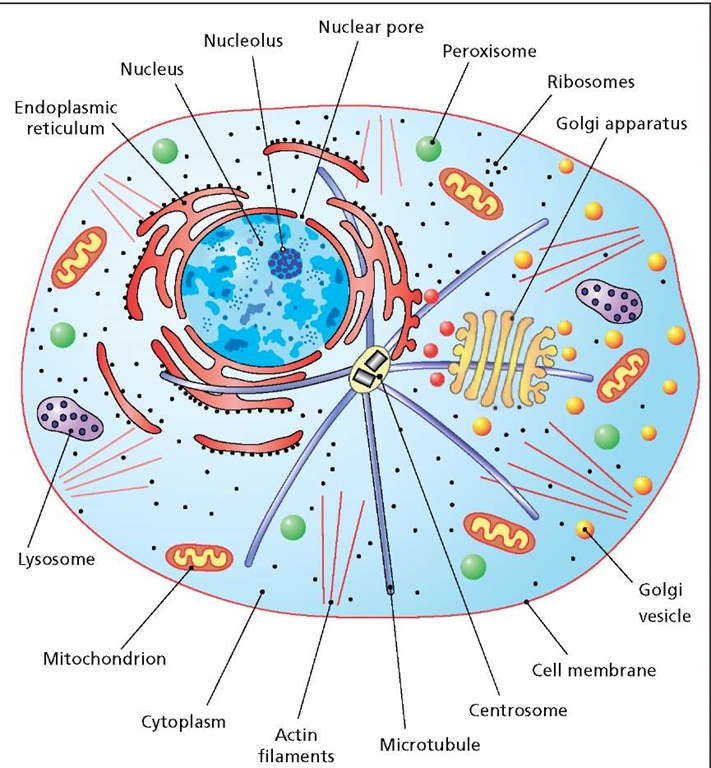Studying the aging process is a complex endeavor that depends on an understanding of cell biology and a variety of research techniques known as biotechnology. This topic provides an introduction to these topics as well as brief discussions of gene therapy, the human genome project, and the design of clinical trials.
Cell biology
A cell is a microscopic life-form made from a variety of nature’s building blocks. The smallest of these building blocks are subatomic particles known as quarks and leptons that form protons, neutrons, and electrons, which in turn form atoms. Scientists have identified more than 200 atoms, each of which represents a fundamental element of nature; carbon, oxygen, and nitrogen are common examples. Atoms, in their turn, can associate with one another to form another kind of building block known as a molecule. Sugar, for example, is a molecule constructed from carbon, oxygen, and hydrogen, while ordinary table salt is a molecule consisting of just two elements: sodium and chloride.
Nature’s building blocks. Particles known as quarks and leptons, created in the heat of the big bang, formed the first atoms, which combined to form molecules in the oceans of the young Earth. Heat and electrical storms promoted the formation of macromolecules, providing the building blocks for cells, which in turn went on to form multicellular organisms.
Molecules can link up with one another to form yet another kind of building block known as a macromolecule. Macromolecules, present in the atmosphere of the young Earth, gave rise to cells, which in turn went on to form multicellular organisms; in forming those organisms, cells became a new kind of building block.
The Origin of Life
Molecules essential for life are thought to have formed spontaneously in the oceans of the primordial Earth about 4 billion years ago. Under the influence of a hot stormy environment, the molecules combined to produce macromolecules, which in turn formed microscopic bubbles that were bounded by a sturdy macromolecular membrane analogous to the skin on a grape. It took about half a billion years for the prebiotic bubbles to evolve into the first cells, known as prokaryotes, and another 1 billion years for those cells to evolve into the eukaryotes. Prokaryotes, also known as bacteria, are small cells (about five micrometers in diameter) that have a relatively simple structure and a genome consisting of about 4,000 genes. Eu-karyotes are much larger (about 30 micrometers in diameter), with a complex internal structure and a very large genome, often exceeding 20,000 genes. These genes are kept in a special organelle called the nucleus (eukaryote means "true nucleus"). Prokaryotes are all single-cell organisms, although some can form short chains or temporary fruiting bodies. Eukaryotes, on the other hand, gave rise to all of the multicellular plants and animals that now inhabit the Earth.
A Typical Eukaryote
Eukaryotes assume a variety of shapes that are variations on the simple spheres from which they originated. Viewed from the side, they often have a galactic profile, with a central bulge (the nucleus), tapering to a thin perimeter. The internal structure is complex, being dominated by a large number of organelles.
The eukaryote cell. The structural components shown here are present in organisms as diverse as protozoans, plants, and animals. The nucleus contains the DNA genome and an assembly plant for ribosomal subunits (the nucleolus). The endoplasmic reticulum (ER) and the Golgi work together to modify proteins, most of which are destined for the cell membrane. These proteins travel from the ER to the Golgi and from the Golgi to their final destination in transport vesicles (red and yellow spheres). Mitochondria provide the cell with energy in the form of ATP. Ribosomes, some of which are attached to the ER, synthesize proteins. Lysosomes and peroxisomes recycle cellular material. The microtubules and centrosome form the spindle apparatus for moving chromosomes to the daughter cells during cell division. Actin and other protein filaments form a weblike cytoskeleton.
The functional organization of a eukaryote is analogous to a carpentry shop, which is usually divided into two main areas: the shop floor where the machinery, building materials, and finishing rooms are kept, and the shop office, where the work is coordinated and where the blueprints are stored for everything the shop makes. Carpentry shops keep a blueprint on file for every item that is made. When the shop receives an order, perhaps for a chair, someone in the office makes a copy of the chair’s blueprint and delivers it to the carpenters on the shop floor. In this way the master copy is kept out of harm’s way, safely stored in the filing cabinet. The carpenters, using the blueprint copy and the materials and tools at hand, build the chair, and then they send it into a special room where it is painted. After the chair is painted, it is taken to another room where it is polished and then packaged for delivery. The energy for all of this activity comes through the electrical wires, which are connected to a power generator somewhere in the local vicinity. The shop communicates with other shops and its customers by using the telephone, e-mail, or postal service.
In the cell the shop floor is called the cytoplasm, and the shop office is the nucleus. Eukaryotes make a large number of proteins, and they keep a blueprint for each one, only in this case the blueprints are not pictures on pieces of paper but molecules of deoxyribonu-cleic acid (DNA) that are kept in the nucleus. A cellular blueprint is called a gene, and a typical cell has thousands of them. A human cell, for example, has 30,000 genes, all of which are kept on 46 separate DNA molecules known as chromosomes (23 from each parent). When the cell decides to make a protein, it begins by making a ribo-nucleic acid (RNA) copy of the protein’s gene. This blueprint copy, known as messenger RNA, is made in the nucleus and delivered to the cell’s carpenters in the cytoplasm. These carpenters are enzymes that control and regulate all of the cell’s chemical reactions. Some of the enzymes are part of a complex protein-synthesizing machine known as a ribosome. Cytoplasmic enzymes and the ribosomes synthesize proteins using mRNA as the template, after which many of the proteins are sent to a compartment, known as the endoplasmic reticulum (ER), where they are glycosylated or "painted" with sugar molecules. From there they are shipped to another compartment called the Golgi apparatus, where the glycosylation is refined before the finished products, now looking like molecular trees, are loaded into transport bubbles and shipped to their final destination.
The shape of the cell is maintained by an internal cytoskeleton comprising actin and intermediate filaments. Mitochondria, once free-living prokaryotes, provide the cell with energy in the form of adenosine triphosphate (ATP). The production of ATP is carried out by an assembly of metal-containing proteins, called the electron transport chain, located in the mitochondrion inner membrane. Ly-sosomes and peroxisomes process and recycle cellular material and molecules. The cell communicates with other cells and the outside world through a forest of glycoproteins, known as the glycocalyx, that covers the cell surface. Producing and maintaining the glycocalyx is the principal function of the ER and Golgi apparatus and a major priority for all eukaryotes.
Cells are biochemical entities that synthesize many thousands of molecules. Studying these chemicals, as well as the biochemistry of the cell, would be extremely difficult were it not for the fact that most of the chemical variation is based on six types of molecules that are assembled into just five types of macromolecules. The six basic molecules are: amino acids, phosphate, glycerol, sugars, fatty acids, and nucleotides. The five macromolecules are: proteins, DNA, RNA, phospholipids, and sugar polymers called polysaccharides.
Molecules of the cell
Amino acids have a simple core structure consisting of an amino group, a carboxyl group, and a variable R group attached to a carbon atom. There are 20 different kinds of amino acids, each with a unique R group. The simplest and most ancient amino acid is glycine, with an R group that consists only of hydrogen. The chemistry of the various amino acids varies considerably: Some carry a positive electric charge, while others are negatively charged or electrically neutral; some are water soluble (hydrophilic), while others are hydrophobic.
Molecules of the cell. Amino acids are the building blocks for proteins. Phosphate is an important component of many other molecules and is added to proteins to modify their behavior. Glycerol is an alcohol that is an important ingredient in cell membranes and fat. Sugars, like glucose, are a primary energy source for most cells and also have many structural functions. Fatty acids are involved in the production of cell membranes and storage of fat. Nucleotides are the building blocks for DNA and RNA. Note that the sugar carbon atoms are numbered. P: Phosphate, C: Carbon, H: Hydrogen, O: Oxygen, N: Nitrogen, R: Variable molecular group.
Phosphates are extremely important molecules that are used in the construction, or modification, of many other molecules. They are also used to store chemical-bond energy in the form of adenosine triphosphate (ATP). The production of phosphate-to-phosphate chemical bonds for use as an energy source is an ancient cellular process, dating back at least 2 billion years.
Glycerol is a simple three-carbon alcohol that is an important component of cell membranes and fat reservoirs. This molecule may have stabilized the membranes of prebiotic bubbles. Interestingly, it is often used today as an ingredient in a solution for making long-lasting soap bubbles.
Sugars are versatile molecules, belonging to a general class of compounds known as carbohydrates that serve a structural role as well as providing energy for the cell. Glucose, a six-carbon sugar, is the primary energy source for most cells and the principal sugar used to glycosylate the proteins and lipids that form the outer coat of all cells. Plants have exploited the structural potential of sugars in their production of cellulose; wood, bark, grasses, and reeds are all polymers of glucose and other monosaccharides. Ribose, a five-carbon sugar, is a component of nucleic acids as well as the cell’s main energy depot, ATP.Ribose carbons are numbered as 1′ (1 prime), 2′, and so on. Consequently, references to nucleic acids, which include ribose, often refer to the 3′ or 5′ carbon.
Fatty acids consist of a carboxyl group (the hydrated form is called carboxylic acid) linked to a hydrophobic hydrocarbon tail. These molecules are used in the construction of cell membranes and fat. The hydrophobic nature of fatty acids is critically important to the normal function of the cell membrane since it prevents the passive entry of water and water-soluble molecules.
Nucleotides are building blocks for DNA and RNA. These molecules consist of three components: a phosphate, a ribose sugar, and a nitrogenous (nitrogen-containing) ring compound that behaves as a base in solution (a base is a substance that can accept a proton in solution). Nucleotide bases appear in two forms: a single-ring nitrogenous base, called a pyrimidine, and a double-ringed base, called a purine. There are two kinds of purines (adenine and guanine), and three pyrimidines (uracil, cytosine, and thymine). Ura-cil is specific to RNA, substituting for thymine. In addition, RNA nucleotides contain ribose, whereas DNA nucleotides contain de-oxyribose (hence the origin of their names). Ribose has a hydroxyl (OH) group attached to both the 2′ and 3′ carbons, whereas deoxy-ribose is missing the 2′ hydroxyl group.



